Local accident investigation
The local accident investigation serves in Germany by evaluating road traffic accidents to uncover accident-prone locations and to investigate them more closely. It must take place in close cooperation between the police , road construction and road traffic authorities , which together form the accident commission. These accident commissions (also known as road safety commissions) are usually formed in accordance with the state decrees. The procedures are standardized by relevant regulations and largely uniform nationwide.
The legal basis for the local accident investigation is the General Administrative Regulations for Road Traffic Regulations (VwV-StVO) to Section 44, as well as the related state ordinances.
Required data
Traffic accident data that the police collects as part of the traffic accident recording at the scene of the accident are processed in order to provide all members of the Accident Commission with the necessary documents that they need to recognize, evaluate and eliminate accumulations of accidents. The absolute number of accidents lead to a distinction in:
- Accident hot spots (UHS)
- Accident accumulation line (UHL)
In addition, data from the so-called accident category are included in the assessment.
methodology
The methodology of the local accident investigation is regulated in the general administrative regulation for the road traffic regulations (VwV-StVO) and detailed in the leaflet on the local accident investigation in accident commissions (M Uko) . For this purpose, the police usually create accident type cards (also known as accident plug-in cards) in which every traffic accident is recorded. A needle is stuck at the exact point on a large-scale map where the accident occurred. The different colors show the type of accident (conflict process that led to the accident) and the different needle diameters show the accident category (fatalities, seriously and slightly injured as well as property damage). This processing of the data makes it possible to localize accumulations at a glance and allows the first indications of possible causes to be identified. In addition, the needles can be provided with markings (small triangles) that indicate further accident circumstances in terms of the cause of the accident (alcohol accident , wildlife accident ) or the type of accident (impact on a tree, pedestrian , cyclist ).
In addition to the map, collections of accident sheets are kept that contain further detailed data, for example on the course of the accident, road conditions, weather, visibility, etc.
Accident type maps and accident sheets are usually kept in electronic form today, with the anonymized logs being processed directly in the police database.
The prepared documents are discussed at regular intervals in the accident commissions. The task of the committee is to interpret the data and propose possible solutions, which then have to be implemented by the politically responsible. Accident commissions have existed in all federal states since the 1970s. They are an important part of the entire spectrum of road safety work and it is not least thanks to their work that the number of deaths and injuries in road traffic is steadily decreasing.
The work of the accident commissions is significantly supported by the accident research of the insurers (UDV) in that training courses are carried out and corresponding specialist publications are issued.
Accident types catalog
The accident type describes the traffic or conflict process from which the traffic accident arose. The accident investigation distinguishes between seven accident types:
- Accident type 1: driving accident (F)
- Accident type 2: turning accident (AB)
- Accident type 3: turning / crossing accident (EK)
- Accident type 4: Exceeding accident (ÜS)
- Accident type 5: accident caused by stationary traffic (RV)
- Accident type 6: accident in longitudinal traffic (LV)
- Accident type 7: other accident (SO)
literature
- FGSV (2012): Leaflet on on-site accident investigations in accident commissions - M Uko . Edition 2012. Cologne: FGSV-Verlag.
- Evaluation of road traffic accidents Part 1. Management and evaluation of accident type plug-in cards . Recommendations of the Institute for Road Traffic, Issue No. 12, Accident Research of Insurers (UDV), ISSN 0724-3685 ( PDF; 2.6 MB; no longer available online ; excerpts from p. 37 in UDV additional information ). Leaflet for the evaluation of road traffic accidents. Part 1: Management and evaluation of accident type plug-in cards . FGSV-Verlag, Cologne 2003.

